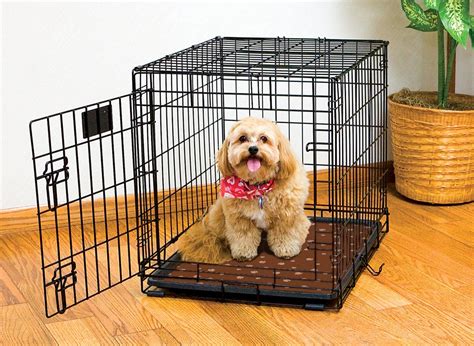Learn the ins and outs of crate training for dogs, from choosing the right size to handling separation anxiety and potty training effectively.
Understanding Crate Training for Dogs
When it comes to crate training for dogs, it’s important to understand the purpose and benefits of using a crate. Crate training can provide a safe and comfortable space for your dog, as well as aid in potty training and managing separation anxiety. By creating a positive association with the crate, you can help your dog feel secure and relaxed in their own space.
Choosing the right crate size is essential for the success of crate training. The crate should be large enough for your dog to stand up, turn around, and lie down comfortably, but not so large that it allows for accidents to occur in one corner. Proper sizing of the crate will help prevent your dog from using one area as a bathroom, promoting good potty habits.
Introducing the crate in a positive way is crucial for your dog’s acceptance of their new space. Start by placing treats and toys inside the crate to entice your dog to explore. Use positive reinforcement and praise when your dog enters the crate voluntarily, and never force them inside. With patience and consistency, your dog will come to see the crate as a safe and enjoyable place to be.
Choosing the Right Crate Size
When it comes to choosing the right size crate for your dog, it’s important to consider their adult size as well as their current size. You want to select a crate that will accommodate your dog as they grow, but isn’t so large that it feels too spacious for them. A good rule of thumb is to choose a crate that allows your dog to stand up, turn around, and lay down comfortably without being cramped. Measure your dog from the tip of their nose to the base of their tail, and from the top of their head to the ground to ensure you select the appropriate size crate.
Consider the breed and weight of your dog when selecting a crate size. Larger breeds will require larger crates, while smaller breeds will be more comfortable in smaller crates. It’s important to select a crate that is not too big or too small to ensure your dog feels secure and comfortable in their space. A crate that is too large may allow for your dog to have an accident in one corner and retreat to another, defeating the purpose of crate training for potty training.
Keep in mind that some dogs may feel more secure in a cozy, den-like environment, so choosing a size that provides a snug fit without being too constricting can help your dog feel safe and secure in their crate. Taking the time to measure and select the right size crate for your dog will set them up for success in crate training and create a comfortable space for them to retreat to when they need some alone time.
Introducing the Crate in a Positive Way
When it comes to introducing a crate to your dog, it’s important to do so in a positive and gentle manner. The crate should not be seen as a punishment, but rather as a safe and cozy space for your furry friend. To start, place the crate in a quiet and comfortable area of your home where your dog can see and smell it. It’s important to make the crate inviting by adding a soft blanket, some toys, and perhaps a treat or two inside to entice your dog to explore.
Once the crate is set up, allow your dog to approach it on their own terms. Let them sniff around and investigate the crate at their own pace. Avoid forcing your dog into the crate or leaving them inside for extended periods of time right away. Instead, encourage positive associations by placing treats inside the crate and praising your dog when they go in on their own. This will help them see the crate as a positive and rewarding space.
As your dog becomes more comfortable with the crate, gradually increase the amount of time they spend inside with the door closed. Start with just a few minutes at a time and gradually work up to longer periods. Always make sure to provide plenty of praise, treats, and attention when your dog is inside the crate to reinforce positive associations. With patience and consistency, your dog will come to see the crate as a safe and comforting space where they can relax and unwind.
Creating a Safe and Comfortable Space
When it comes to crate training for dogs, one of the most important aspects is creating a safe and comfortable space for your furry friend. The crate should be a place where your dog feels secure and at ease, so it’s essential to choose the right size and type of crate. It’s recommended to go for a crate that is spacious enough for your dog to stand up, turn around, and lie down comfortably. The crate should also be made of sturdy materials to ensure your dog’s safety.
Once you have the right crate, it’s time to make it cozy and inviting for your dog. You can add soft bedding, toys, and treats to the crate to make it a pleasant and positive environment. Additionally, placing the crate in a quiet and peaceful area of your home can help your dog feel more relaxed while in the crate.
Creating a safe and comfortable space also involves making sure that your dog has access to food, water, and potty breaks while in the crate. It’s important to monitor your dog’s needs and ensure that they are comfortable and not stressed while in the crate. By taking these steps, you can create a safe and comfortable space for your dog that will make crate training a positive experience for them.
Using Crate Training for Potty Training
When it comes to potty training your dog, using crate training can be a highly effective method. Crate training is a great way to teach your dog how to control their bladder and bowels, as well as provide them with a safe and comfortable space.
First, it’s important to choose the right size crate for your dog. The crate should be large enough for your dog to stand up, turn around, and lay down comfortably, but not too large that they can use one side as a bathroom area. This helps to encourage your dog to hold their bladder and bowels while in the crate.
Introducing the crate in a positive way is crucial for successful potty training. Make sure the crate is associated with positive experiences, such as meals, treats, and toys. You can also gradually increase the time your dog spends in the crate, always making sure to praise and reward them for using the bathroom outside of the crate.
Handling Separation Anxiety with Crate Training
Separation anxiety is a common problem among dogs, especially those who have a strong bond with their owners. It can lead to destructive behavior, excessive barking, and other issues when the dog is left alone. Crate training can be a helpful tool in managing separation anxiety and providing a safe space for the dog when the owner is away.
When using crate training to address separation anxiety, it’s important to make the crate a positive and comfortable environment for the dog. Start by introducing the crate gradually, allowing the dog to explore it at their own pace. Use treats, toys, and praise to create a positive association with the crate, and never force the dog into the crate as this can worsen their anxiety.
Another key aspect of using crate training for separation anxiety is to make sure the dog has plenty of exercise and mental stimulation before being crated. A tired and mentally stimulated dog is more likely to settle down and relax in the crate, reducing the likelihood of anxiety-related behaviors. Additionally, it’s important to avoid making a big deal out of leaving or returning home, as this can reinforce the dog’s anxiety. Instead, practice leaving the dog alone for short periods of time and gradually increasing the duration as they become more comfortable with being crated.
Gradual Transition to Freedom in the House
One of the most rewarding aspects of crate training for dogs is the eventual transition to freedom in the house. When done correctly, this process can provide your furry friend with a sense of independence while ensuring their safety and the safety of your home. It’s important to approach this transition gradually and with caution to prevent any setbacks in your dog’s training.
First and foremost, it’s crucial to ensure that your dog is fully comfortable and well-adjusted to their crate before considering a transition to freedom in the house. This means that they should view their crate as a safe and secure space, and not feel anxious or stressed when confined to it. Slowly introduce your dog to being in the house without being in the crate, starting with short periods of time and gradually increasing as they demonstrate good behavior and reliability.
During this transition period, it’s important to provide plenty of positive reinforcement and rewards for good behavior while your dog is out of the crate. Use treats, praise, and toys to encourage positive behaviors and discourage any unwanted behaviors. It’s also important to closely monitor your dog during this time, as any signs of anxiety or destructive behavior should prompt a return to the crate until they are ready for more freedom.
Frequently Asked Questions
What is crate training?
Crate training is a method of training dogs to stay in a crate or kennel while their owners are away or unable to supervise them.
Is crate training cruel to dogs?
When done properly, crate training can provide a safe and comfortable space for dogs, similar to a den in the wild. It should not be used for punishment.
How can I start crate training my dog?
Start by introducing the crate as a positive space, using treats and toys to encourage your dog to enter. Gradually increase the time they spend inside, always making it a positive experience.
What are the benefits of crate training?
Crate training can help with potty training, prevent destructive behavior when unsupervised, and provide a safe haven for dogs in stressful situations.
How long can a dog be crated?
Adult dogs can typically be crated for 4-6 hours, while puppies may need more frequent breaks. It’s important to gradually increase the time they spend in the crate and never leave them for extended periods.
Should I leave food and water in the crate?
It’s best to remove food and water from the crate to prevent accidents and encourage your dog to hold their bladder while inside. Provide meals and water outside of the crate.
Can all dogs be crate trained?
Most dogs can be successfully crate trained, but some may have anxiety or past trauma that makes crating stressful. In these cases, alternative methods should be considered.





